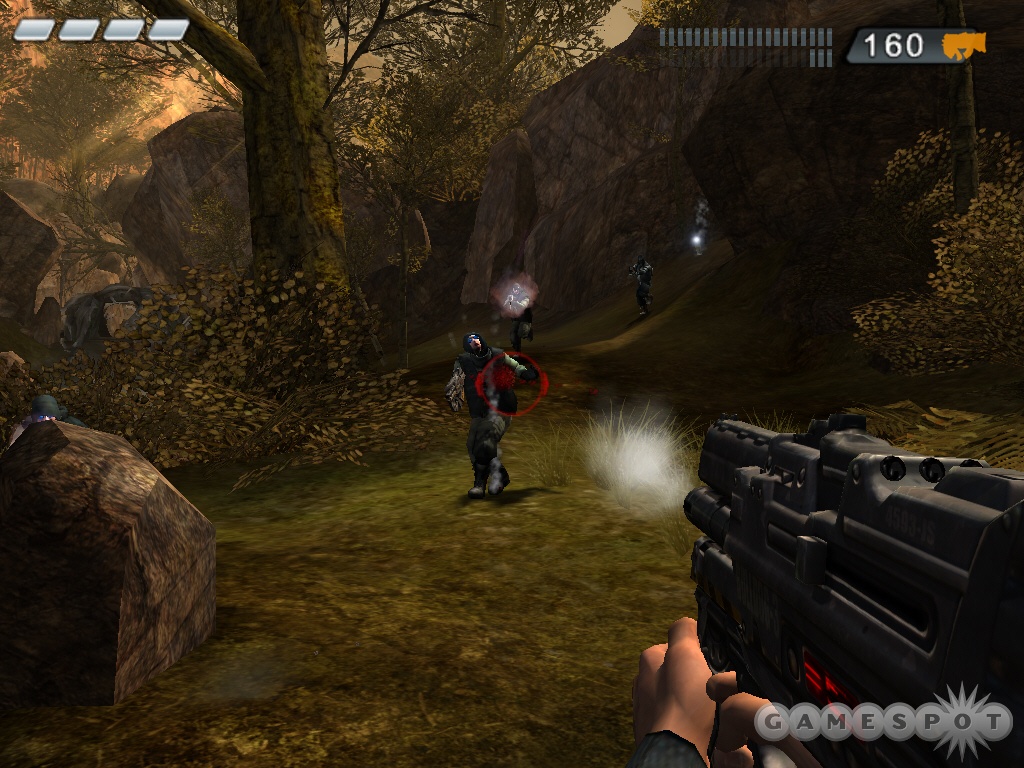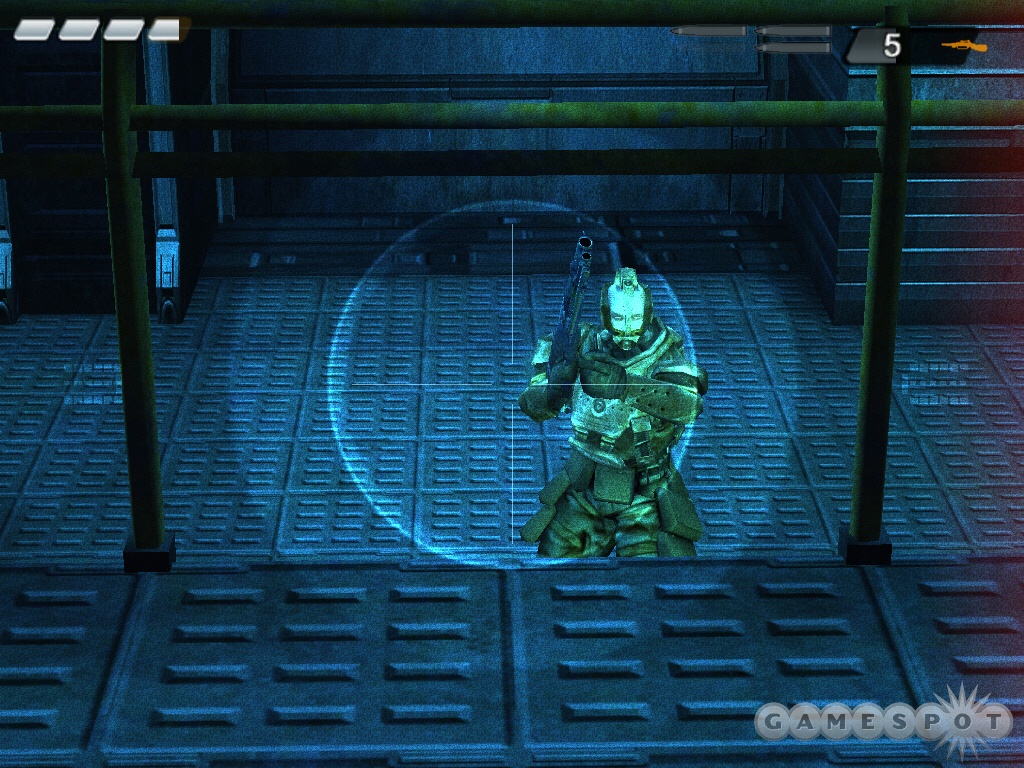Pariah Hands-On
With Pariah shipping early next month, we get our hands on the preview code so we can go at it.
Digital Extremes is perhaps best known for codeveloping the many Unreal and Unreal Tournament games that have appeared since 1998. Prior to that, the company, which has been around for more than a decade, was best known for its pinball video games. So it's safe to say the company is entering new territory with Pariah, a new sci-fi shooter that will ship for the PC and Xbox early next month. Of course, we've got the exclusive preview code and have engaged in some serious hands-on time with it.
Pariah tells the tale of Jack Mason, a military doctor in the year 2520. While riding along on an emergency evacuation of a quarantined prisoner infected with some unknown disease, Mason finds himself shot down and surrounded in hostile territory. Even worse, the infected patient is loose and on the run. At this point, you're given control of Mason. You then have the job of navigating through the game's many levels, battling all sorts of enemies, jumping in and controlling various vehicles, and much more in your quest to rescue the patient and then get the heck out of there.

On first look, it's fairly easy to mistake Pariah for an Unreal game, given Digital Extreme's long work with that franchise, as well as the fact that Pariah uses the current version of the Unreal engine. It's certainly a beautiful game, and you get to explore and battle in outdoor environments that are well rendered and well realized. Battle it out among the concrete pillars of a bridge, for example, and bullets will shatter the cement, sending fragments flying through the air. The game also incorporates Havok physics, which let you hurl enemy soldiers into the air through the force of explosions, courtesy of the many explosive barrels that are scattered throughout most levels. It's funny how those explosive barrels are pretty much universal, isn't it?
We've played through the early levels, which are a mix of indoor and outdoor environments set in forest and wilderness regions. Like most shooters, Pariah features a fairly linear level design, which means you can't get lost, as you're usually funneled in one direction. The levels are rather straightforward, and there's some simple puzzle-solving to be done, such as having to figure out how to power up a lift or looking for the switch to open up the next locked door. You'll also want to explore every nook and cranny to look for weapon energy cores, which play an important role in the game.
The weapons in Pariah are a very interesting mix of the familiar and the new. You can call up a circular weapons menu that lets you quickly switch between the game's many arms. This also lets you play around with the weapon upgrade system, which begins when you start collecting energy cores. Basically, each weapon has the ability to be upgraded three times, provided you have enough energy cores. The first upgrade costs one core, the second upgrade costs two cores, and the third upgrade costs, well, three cores. So to fully upgrade a weapon from scratch, you'll need a total of six cores. Of course, the challenge will be to figure out which weapons you want to upgrade, because, naturally, you only have a limited number of cores.

Even the most basic upgrade can have a profound effect. For instance, the frag rifle, which is the Pariah equivalent of a shotgun, is a fairly powerful weapon. But it has one glaring weakness: It takes forever and a half to reload during a firefight. Dump one of your energy cores for the frag rifle's servo reloader upgrade, and you'll get a much more effective weapon thanks to an improved reload rate. Further upgrades will improve the punch of the frag rifle considerably. In the case of the sniper rifle, the first upgrade will turn the scope into an enhanced thermal sight, while the second upgrade will expand the rifle's magazine clip. Finally, the third upgrade adds armor-piercing capabilities to ensure that one-shot kill against the many armored opponents that appear in the game.
Most of the weapons should be familiar to fans of the first-person-shooter genre. There's an assault-style rifle called the bulldog, as well as a rocket launcher, a grenade launcher, and a plasma gun. For melee attacks, you can use your bone saw. But if an enemy gets that close to you, it's probably bad news. Ammunition isn't much of a problem, either, as enemies drop plenty of ammo and health packs. Speaking of which, the health system is something that we've covered in previous previews...but it's worth noting again. Pariah uses something of a blend between a Halo-style recharging health system and a Chronicles of Riddick-style health box system. Your character has four health boxes, and each time you take damage, it drains one of them. Sustaining too much damage will empty a box, so further damage is absorbed by the next box. If you manage to avoid incoming fire for a few seconds, a partially drained box will fill up automatically. However, a completely drained box will remain empty. To recover to full health, you must use your healing tool to restore empty boxes. The healing tool, like the weapons, can be upgraded: first with a quick injector, next with a healing boost, and, finally, with an adrenal increase.
The enemies each pose different challenges. The most common foe is the regular grunt, a soldier who's fairly easy to dispatch. However, later on you'll need to upgrade your weaponry to keep up with the grunt's increased levels of armor. Then there are the foes with the flamethrowers that can definitely deal out damage as they get close to you. The good news is that you get the satisfaction of seeing them explode in flames if you puncture their fuel tanks. Another opponent carries a type of heavy shield that makes it difficult to take him out with a rifle. But this just gives you an opportunity to use the grenade launcher to hurl a grenade behind the protective shield. Pariah does feature numerous vehicles you can jump into and drive, and early on, you get an opportunity to ride around in the Bogie, a four-wheeled all-terrain vehicle with a big gun mounted on top. The Bogie lets you get around some of the lengthy levels quickly, and it can absorb a fair amount of damage, though the driving physics take some getting used to. Later on, you'll also get to ride as the gunner on the Bogie, allowing you to open up with the built-in machine gun and rocket launcher.

We didn't get a chance to play around with the multiplayer features of Pariah, given that we only had one copy of it. Still, we've covered the multiplayer modes extensively in earlier previews, including the innovative level editor, which represents a first for a console shooter. The ability for Xbox players to create and share entire new multiplayer levels should definitely extend the life of the game. Pariah looks to be a fairly solid first-person shooter, and its rich visuals and multiplayer possibilities will definitely appeal to those who enjoyed the Unreal games, as well as other sci-fi shooters. Pariah is practically finished at this point and will ship for both the PC and Xbox in early May.
Got a news tip or want to contact us directly? Email news@gamespot.com
Join the conversation